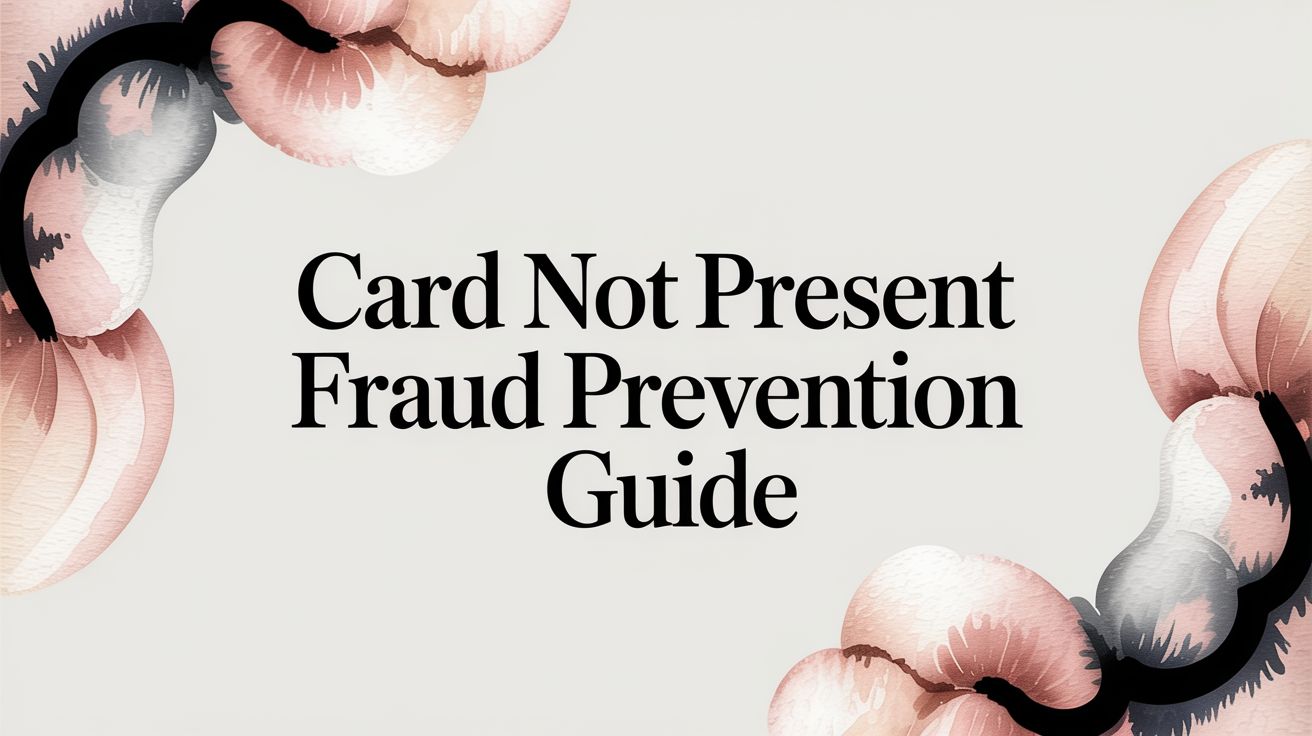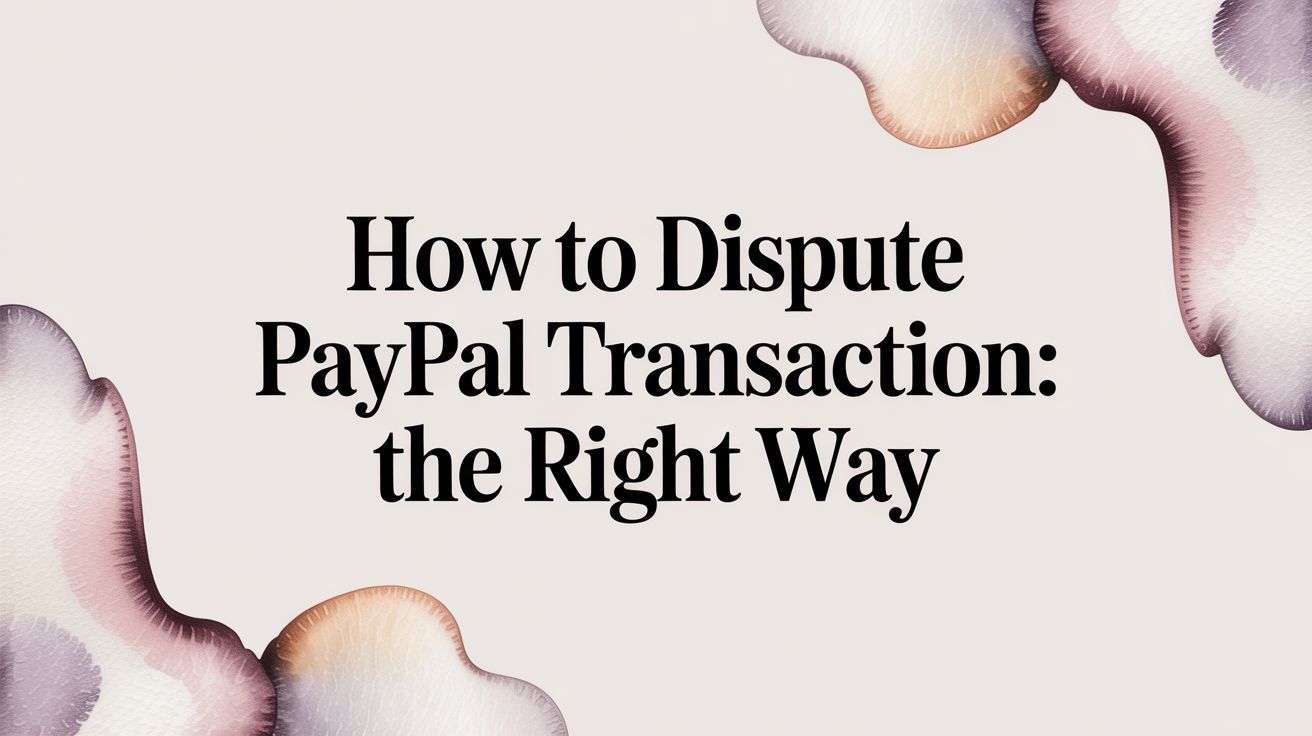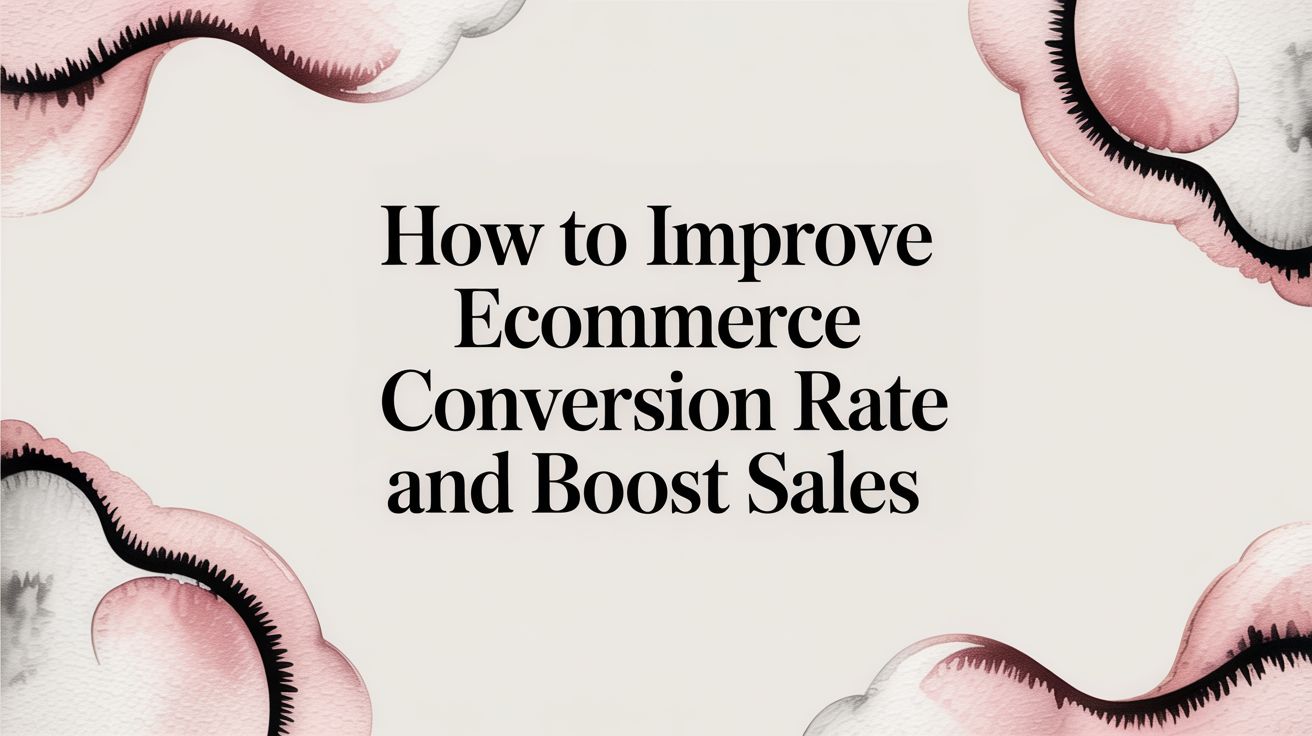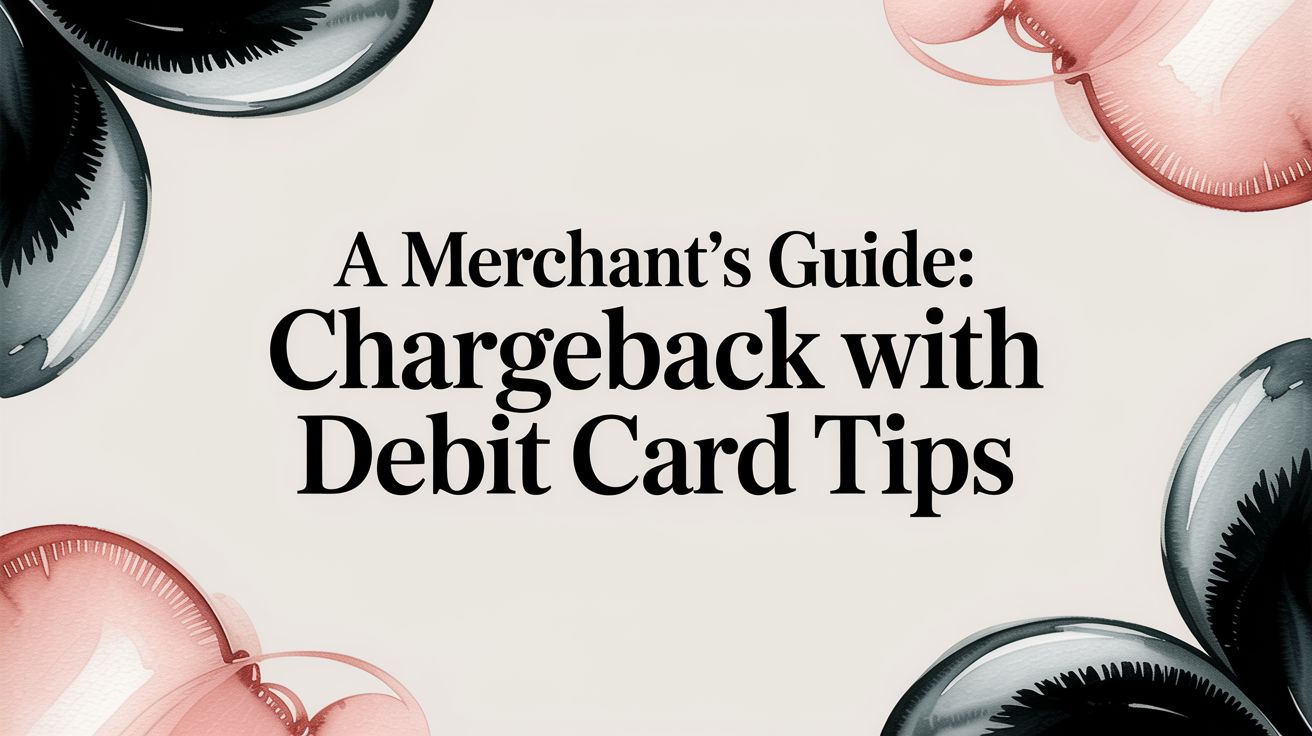
A card-not-present (CNP) transaction is pretty much what it sounds like: a payment made without the physical credit or debit card being swiped, tapped, or inserted. Think about the last time you ordered a pizza over the phone—you read your card details to the cashier, but they never actually saw or held your card. That's a CNP transaction in a nutshell, and it’s the engine driving modern e-commerce.
What Card-Not-Present Really Means for Your Business

If you run an online store or take any kind of payment remotely, you’re dealing with card-not-present transactions every single day. The real difference between a CNP payment and an in-person one boils down to one thing: verification.
When a customer pays at a physical store, they might use a chip card or tap their phone. That physical interaction adds a strong, built-in layer of security. But in a CNP scenario, you’re trusting the data the customer provides—the card number, expiration date, and CVV. This is why these transactions, while incredibly convenient, naturally carry a higher risk of fraud.
Where These Transactions Happen
Card-not-present payments are everywhere, and they go far beyond your typical online shopping cart. They are the backbone of any business that sells remotely. You'll find them in a few key places:
- Online Purchases: This is the big one. It covers everything from buying a new pair of sneakers on an e-commerce site to ordering your weekly groceries for delivery.
- Phone Orders: Any time a customer calls you to place an order and gives you their card details verbally, it’s a classic CNP transaction.
- Mail Orders: It might feel a bit old-school, but payments made by filling out a form and mailing it in also fall under the card-not-present umbrella.
- Recurring Payments: Think about subscription services like Netflix or your monthly software bill. You enter your card info once, and every automatic charge after that is handled as a CNP transaction.
Getting a handle on all these payment types is crucial for any merchant. If you want to dig deeper into the mechanics of how different payments work, check out our detailed guide on credit card transactions.
The Growing Importance of CNP
The massive shift to online and remote business has sent these types of payments through the roof. As shoppers fell in love with digital convenience—and as chip cards made in-person fraud much tougher—CNP transactions absolutely exploded.
The value of card-not-present transactions on major networks like Visa and Mastercard skyrocketed more than fivefold in just a decade, ballooning from $360 billion in 2011 to a staggering $1.8 trillion in 2021.
This incredible growth just goes to show how vital CNP payments are for modern businesses. But it also means that having a smart strategy to manage their unique risks is more important than ever. You can read more about this trend in research from the Kansas City Fed.
Why Online Transactions Carry More Risk
Think about the last time you bought something in a physical store. You probably tapped or inserted your chip card, and that was that. That little microchip is a powerhouse of security, creating a unique, one-time-use code for that single transaction. It’s like a secret handshake between the card and the terminal, making it incredibly difficult for a fraudster to clone or counterfeit.
Now, shift gears to an online purchase—a card not present transaction. That physical verification is completely gone. Instead of a secure chip, the entire transaction hinges on static information: the card number, expiration date, and CVV. If a criminal has snagged that data from a phishing scam or a data breach, they have all the keys they need. You, the merchant, are left with no physical way to confirm the person on the other end is the legitimate cardholder.
This single difference—physical card vs. static data—creates a massive security gap that fraudsters just love to exploit. It's the reason an online sale has a fundamentally higher risk profile than an in-person one.
The Critical Concept of the Liability Shift
In the world of payments, someone always has to foot the bill when fraud occurs. For most fraudulent in-store purchases made with a chip card, the liability usually lands on the card-issuing bank. They’re the ones who pushed for chip technology, so they accept the risk.
But for a fraudulent card not present transaction, the script is flipped entirely. This is where the liability shift hits home for online merchants.
In the vast majority of CNP fraud cases, the financial responsibility—the liability—shifts from the bank directly to you, the merchant. You’re the one left covering the cost of the stolen goods plus any chargeback fees.
Why? Because you accepted a payment without being able to physically verify the cardholder. This shift makes solid ecommerce fraud prevention not just a smart business practice, but a critical defense for your bottom line.
Comparing the Customer Journey and Security
Let's go back to buying that coffee. You tap your card, the payment goes through in a second, and you walk away. The experience is lightning-fast, simple, and secured by the physical card itself. That's the gold standard for a card-present transaction.
An online checkout is a different beast altogether. Your customer has to manually punch in their card number, name, expiration date, and CVV. They might also need to enter separate billing and shipping addresses. Every single field is a piece of data that could have been compromised. You trade the simple security of a physical tap for the incredible convenience of selling to anyone, anywhere.
The table below breaks down these core differences at a glance.
Key Differences Between Card Present and Card Not Present Transactions
The security measures, risk levels, and even who foots the bill for fraud change dramatically when a transaction moves from a physical store to an online checkout. Here’s a side-by-side look at what that means for you as a merchant.
Understanding these distinctions is the first step toward building a real defense against online fraud. The high stakes involved with CNP transactions also highlight the importance of having protections like ecommerce insurance to shield your business from unexpected financial hits. As you scale, these safeguards become absolutely essential.
Spotting the Common Types of CNP Fraud

If you want to protect your business, you need to understand the fraudster's playbook. The threat isn't always some sophisticated hacker in a dark room—often, it's a much simpler game. Getting familiar with the different flavors of card-not-present fraud helps you spot the red flags before they hit your bottom line.
Fraud is a massive headache for online merchants. For CNP ecommerce transactions, the average chargeback rate is expected to hover between 0.6% and 1% in 2025. That might not sound like a lot, but it’s way higher than the roughly 0.5% seen in physical stores. The reason for the gap is simple: without the card and customer physically there, fraudsters have a huge advantage.
Let's break down the most common tactics you're going to run into.
True Criminal Fraud
This is the classic scenario most of us think of when we hear "credit card fraud." It’s a straightforward crime where a thief gets their hands on stolen credit card information—maybe from a data breach, a phishing email, or malware—and uses it to buy something from your store.
Picture this: you run an online electronics shop. A fraudster, working from a list of stolen card numbers, orders the latest smartphone. They plug in the real cardholder's details but have the phone shipped to a totally different, untraceable address, like a vacant house or a freight forwarder. The actual cardholder eventually sees the charge, calls their bank, and you get slapped with a chargeback.
The biggest giveaway here is often a mismatch between the billing and shipping addresses, especially if the package is heading to a high-risk location.
Friendly Fraud
This one is way more common than you'd think and can be incredibly frustrating because it doesn't start with a criminal. Friendly fraud happens when a legitimate customer buys something from you and then disputes the charge, claiming they never made the purchase or authorized it.
Why would they do this? It boils down to a few reasons:
- Buyer's Remorse: The customer regrets their purchase and figures a chargeback is an easier way out than dealing with your return policy.
- Family Mix-Up: A family member, maybe a teenager, uses their parent's card without asking. The parent sees the charge, doesn't recognize it, and immediately disputes it.
- Confusing Billing Descriptor: Your business name shows up on their statement as something generic like "SP * GLOBAL PAYMENTS" instead of "Tees by Tom," causing them to panic and report it as fraud.
From your end, a friendly fraud purchase looks completely normal. The order comes in, you ship the product, and everything seems perfect… until that chargeback notice lands in your inbox weeks later.
Triangulation Fraud
This scheme is a bit more elaborate, involving three players: the fraudster, an innocent customer, and your store. It’s a sneaky trick where the criminal basically uses your business as an unwitting middleman.
Here’s the step-by-step breakdown:
- The Bait: The fraudster creates a fake online storefront, maybe on a marketplace like eBay, advertising popular products at ridiculously low prices.
- The Order: A real customer stumbles upon this "amazing deal" and places an order, giving the fraudster their actual name, shipping address, and payment details.
- The Switch: Here's the twist. The fraudster takes the customer's name and shipping address but uses a completely different, stolen credit card to buy that same item from your legitimate store. They then have you ship the product directly to the customer who placed the original order on the fake site.
From the merchant's perspective, everything looks almost normal—an order is placed and shipped. The customer gets the item they wanted. But the payment was made with a stolen card. When the real owner of that card reports the fraud, the merchant is the one left without the product and the money.
The customer who got the package is happy, the fraudster now has their payment info for later, and you're left holding the bag. Spotting this is tough, but a major red flag is an order where the customer's name and shipping info seem totally disconnected from the credit card details used for payment.
Your Essential CNP Fraud Prevention Toolkit

Now that you know what the common schemes look like, it’s time to build your defense. Stopping card-not-present fraud isn't about finding a single magic bullet; it's about layering smart tools and strategies together.
Think of it like securing your home. You don't just lock the front door and call it a day. You probably close the windows, maybe set an alarm, and keep an eye out for anything unusual. The same logic applies here.
Each tool in your kit acts as a digital bouncer, checking different bits of information to make sure the person buying from you is legit. By combining them, you create a tough barrier for fraudsters that doesn't get in the way of your real customers.
The Foundational Layers of Security
Let’s start with the basics. These are the non-negotiables that should be part of just about every online transaction. They’re your first line of defense against the most common, low-effort fraud attempts.
Address Verification Service (AVS): This is a simple but incredibly effective check. AVS compares the billing address the customer types in with the address their bank has on file. A mismatch is a classic red flag, often meaning the person using the card doesn't know the real cardholder's details.
Card Verification Value (CVV): You know that three or four-digit code on the back of a credit card? That's the CVV. Requiring this code is crucial because it helps prove the customer physically has the card, something a fraudster who only has a stolen card number likely won't.
These two work hand-in-hand to verify two key things: the buyer knows the cardholder's address, and they have the actual card. You'd be surprised how much fraud they stop all on their own.
Adding Advanced Protection
While AVS and CVV are must-haves, sophisticated fraudsters can sometimes find ways around them. This is where more advanced security layers come into play, giving you extra checkpoints to spot suspicious activity before it ever becomes a chargeback.
One of the most powerful tools here is 3-D Secure. You've probably experienced this yourself when a store sends you to your bank's website to enter a password or a one-time code texted to your phone. This step directly involves the bank in authenticating the purchase, making it extremely difficult for a criminal to complete a fraudulent card-not-present transaction.
This extra verification step happens directly with the cardholder's bank, creating a secure link that your business can trust. Even better, successfully using 3-D Secure can shift the liability for certain fraudulent chargebacks from you, the merchant, back to the card issuer. If you want to dive deeper, you can learn all about what 3-D Secure authentication is in our detailed guide.
Tying It All Together With Smart Analysis
Beyond these specific tools, a truly solid defense uses data to spot weird patterns that might signal fraud. Think of this as your digital detective work.
By looking at transaction data in real-time, you can catch fraud as it happens. A multi-layered approach that combines verification tools with behavioral analysis creates the most effective defense against CNP fraud.
Here are a few other powerful methods to add to your arsenal:
- Geolocation: This tool checks where an order is being placed from based on the customer's IP address. If a purchase is made with a US-based card but the IP address is in another country, it's definitely worth a closer look.
- Velocity Checks: Fraudsters often try to make a bunch of purchases in a very short amount of time before a stolen card gets reported. Velocity checks monitor how often transactions happen and can automatically flag or block an account that suddenly starts ordering way more than usual.
- Device Recognition: This tech can identify the specific device—like a phone or laptop—being used for a purchase. If a single device is suddenly used to place orders with ten different credit cards, that's a massive red flag. You're dealing with a fraudster, not ten separate customers.
Smart Business Practices to Reduce Fraud
While all the high-tech security tools are fantastic, they’re only half the battle. The other half comes down to building smart, consistent habits into your daily operations. Think of it like this: your fraud prevention software is the fancy alarm system, but your business practices are the locked doors and windows—the simple, everyday routines that create a secure environment from the ground up.
These practices aren't complicated or expensive. In fact, some of the most effective moves are just simple rules you follow every time. When you apply them consistently, you can stop a fraudster in their tracks long before a transaction is even processed. This proactive approach is your frontline defense against card-not-present fraud and helps you spot sketchy activity with way more confidence.
Creating Your Operational Checklist
So, how do you put this into practice? Let's build a simple, actionable checklist you can start using today. These habits are all about reviewing orders with a critical eye, setting some logical limits, and talking clearly with your customers.
A few basic rules can make a world of difference:
Always Require the CVV: This one is non-negotiable. Never, ever process a transaction without the Card Verification Value. It’s one of the easiest ways to get a gut check that the person making the purchase actually has the physical card in their hands.
Set Transaction Velocity Limits: Fraudsters move fast. They’ll often hit a stolen card with a bunch of small purchases or one huge one in a very short amount of time. Setting velocity limits—rules that flag or block rapid-fire transactions from the same card or IP address—shuts down these kinds of blitz attacks automatically.
Manually Review High-Risk Orders: Don't be afraid to hit the pause button. If you see an unusually large first-time order, especially for a pricey item with expedited shipping, it deserves a second look. Manually reviewing these orders gives you a chance to verify the customer’s identity before you ship the product and lose both your merchandise and the money.
The Power of Clear Communication
It’s easy to get laser-focused on stopping criminals, but a huge chunk of chargebacks comes from a much simpler place: customer confusion. This is where "friendly fraud" often gets its start, and it’s a problem that good communication can almost completely solve.
When a customer sees a charge on their statement they don't recognize or simply forgets they made a purchase, their first instinct is often to call their bank and dispute it. By being proactive with your communication, you can head off these misunderstandings before they even happen.
Clear and consistent customer communication is one of the most underrated fraud prevention tools you have. It builds trust and creates a paper trail that can help you win disputes that pop up from customer confusion or even buyer's remorse.
For example, sending detailed order confirmations can make a massive impact. Don't just send a generic "Your order has shipped" email. Instead, give your customers comprehensive updates that reinforce the legitimacy of their purchase every step of the way.
Here’s what a great communication workflow looks like:
- Immediate Order Confirmation: The moment a purchase is made, fire off an email. Make sure it includes the order number, a detailed list of the items purchased (with pictures!), the total cost, and the last four digits of the card they used.
- Clear Shipping Updates: Send another notification when the order goes out the door. This one should have a tracking number and an estimated delivery date. This creates a clear timeline the customer can follow along with.
- Follow-Up After Delivery: A simple email confirming the package was delivered and asking if they're happy with everything can solidify the transaction in their memory. Plus, it gives you another piece of evidence if you ever need it.
Streamlining How You Handle Chargebacks
Let's be realistic: even with the best security tools and business practices in place, chargebacks can still happen. The truth about processing card not present transactions is that some disputes are simply unavoidable. At this point, the game shifts from prevention to mounting an efficient and effective response.
Fighting chargebacks manually is a draining, time-consuming process. It means digging through order histories, gathering proof of delivery, pulling up customer communications, and piecing it all together into a compelling case—all while racing against strict deadlines. For many business owners, it’s a manual headache that pulls focus away from actually growing the business.
Turning Manual Work into an Automated Workflow
This is where a dedicated solution like ChargePay completely changes the equation. Instead of you spending hours on tedious administrative work, ChargePay automates the entire dispute process. The platform is built to handle the heavy lifting of gathering evidence and submitting well-structured responses on your behalf.
This infographic shows a simplified view of the key checkpoints in fraud prevention, which form the first line of defense before a chargeback ever occurs.

By automating checks for CVV, setting transaction limits, and enabling manual review, merchants can significantly cut down on initial fraud. But for the ones that inevitably slip through, a smart response system is essential.
What was once a manual, multi-step chore becomes a streamlined workflow. This automation not only saves you countless hours but also significantly increases your chances of winning. By using AI to analyze dispute reasons and assemble the strongest evidence, ChargePay helps merchants recover revenue that would otherwise be lost.
By automating the response process, businesses can see their chargeback win rates increase by up to 3.5 times. This turns a costly problem into a recoverable revenue stream and protects the health of your merchant account.
Effectively managing disputes is a critical skill for any online merchant. To get a more in-depth look at this topic, explore our complete guide on chargeback dispute management. Using the right tool doesn't just help you win more cases; it gives you back the time and peace of mind needed to focus on what you do best—running your business.
Common Questions About Card Not Present Fraud
As we wrap up, you might still have a few questions buzzing around. That’s completely normal. The world of card not present transactions can feel a little complicated at first, but once you get the hang of the key ideas, you’ll feel much more in control.
Let's tackle some of the most common questions we hear from business owners just like you. Think of this as your quick-reference guide for handling those tricky situations.
What Does the Liability Shift Mean for My Small Business?
The liability shift is a huge concept for any online merchant to get their head around. In the simplest terms, it means that for most fraudulent card not present transactions, you (the merchant) are the one left holding the bag—not the bank that issued the card.
This happens because there’s no way to physically check the card and its chip. The good news? You can sometimes shift that liability back to the card-issuing bank by using stronger security tools like 3-D Secure. It's a critical layer of financial protection you shouldn't overlook.
How Can I Fight a Chargeback I Know Is Unfair?
Fighting a chargeback you believe is unfair means you need to put on your detective hat. Your job is to provide compelling evidence that proves the transaction was legit and you delivered on your promise. Responding fast and with detailed proof is everything if you want to win.
Your evidence file should be packed with anything that connects the real cardholder to the purchase:
- Proof of Delivery: This is the big one. Always use a shipping service with tracking and get that delivery confirmation.
- Customer Communications: Save every email, support ticket, or chat log you have with the customer.
- Verification Data: Don't forget to include the AVS and CVV match results from the transaction itself.
- Order Details: Lay out the full order information, from the items purchased to the shipping address.
The more organized and detailed your response, the better your shot at getting that chargeback reversed.
Can My Fraud Prevention Be Too Strict and Block Good Customers?
Yes, absolutely—and it's a major headache for online businesses. When your security rules are too aggressive, you end up declining legitimate transactions from honest, paying customers. This is called a 'false positive,' and it’s a fast track to lost sales and frustrated buyers.
The trick is to find a healthy balance. Instead of a single, all-or-nothing rule, use a layered approach with several different tools. For instance, rather than automatically blocking every order with an AVS mismatch, you could flag it for a quick manual review. This helps you catch actual fraud without turning away real customers who just made a simple typo.
Finding that sweet spot between tight security and a smooth customer experience is everything. Your goal is to stop fraudsters without creating frustrating roadblocks for your legitimate customers.
Are Recurring Payments and Subscriptions Considered CNP?
You bet they are. Since the physical card isn't swiped for each recurring charge, all subscription and automatic billing payments fall squarely into the card not present category. This makes them a hot target for certain kinds of fraud.
If you run a subscription business, it's vital to be extra vigilant with that very first transaction. A fraudulent card on a recurring plan can trigger a series of chargebacks over the next few months. By making sure the initial payment is secure, you're protecting your revenue stream for the long haul.
Navigating chargebacks and fraud is a constant battle, but it doesn't have to eat up all your time and resources. ChargePay automates the entire dispute process, using AI to build and submit winning responses for you. Stop losing revenue to tedious manual work and let our technology do the fighting. Reclaim your time and protect your bottom line by visiting https://www.chargepay.ai.







.svg)







.svg)
.svg)
.svg)